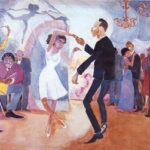Herbert Gutman’s book, The Black Family in Slavery and Freedom 1750-1925 (1976), is a part of revisionist literature in reaction to earlier literature on slavery that emphasized the destructive impact of the institution on African American life. Gutman’s main purpose is to dispel the assertion made by Daniel P. Moynihan in The Negro Family in America: The Case for National Action (1965) that “the deterioration of the Negro family,” were “rooted.in a historical process that had its origins in the enslavement of seventeenth-and eighteenth-century Africans” (Gutman xxvi). In contrast to this view by Moyhihan and others like him, Gutman argues that chief among the sustaining values of slave life was the family. His intent was not just to show how the family was challenged or how it survived, as earlier works had done, but to show family as a means of keeping African American cultural ways and history intact. The family was about belonging and developing kin ships and maintaining a vehicle to transmitting group history. Gutman demonstrates that slaves, in spite of their condition, did exercise some control over their lives and developed their own unique patterns of culture and social organization. His book is as much about the existence of a black family unit as it is about its function.
Gutman’s book provides a look at the black family from slavery to 1925, by examining topics such as: (1) the ways they defined their roles and identities as men and women and the ways in which others have defined and distorted these roles; (2) the nature of their intimate relations as lovers, partners, wives, and husbands; (3) and the nature of the relationships between black men and women, mothers, sons and daughters. These roles, identities, and relations overlap with what is the black family. Gutman uses the positivist method of quantitative sociology, in an attempt to validate statements about the black family with sampled data analyzed statistically. He uses primary sources such as census reports and marriage registers. He supplements this data with autobiographical and anecdotal sources, including reports of life on plantations. This data points to the establishment of a nuclear household. Gutman focuses primarily on the family unit and showed that a unit consisting of man, woman, and child existed in about two-thirds of the cases of slave unions during the last decades of slavery on the large plantations in the Southeast. This was a nuclear family supported by the slave owner, who wanted his slaves to breed as many children as possible, but was unwilling to invest in adequate living conditions for this family. Large plantations, because they had greater numbers of slaves and relatively fewer Whites, allowed for more genuine family units and marriage unions.
According to Gutman, in spite of variations in languages and cultural practices, there were common underlying patterns of gender and familial relations that the slaves brought from West Africa. The came from kin-based societies. With the exception of a few bilateral societies, kinship systems were organized into unilineal descent groups. Membership was determined either through the mother’s line (matrilineal systems) or the father’s line (patrilineal systems). Gutman showed that these lineages determined an individual’s status and role in society and the rights and privileges to which they were entitled. Kinship was paramount and became the means by with all social relations were structures, so that even if two people were not related by blood, there was a strong tendency to interpret their relationship in kinship terms if they had a close bond with each other. According to Gutman, “Kin networks broke out of the boundaries fixed by ownership and thereby connected men, women and children of similar and different slave generations who belonged to different owners” (135).
One of the main points of the book is that slavery had a traumatic impact on both genders and on all aspects of life for the Africans. The organizational aspects of West African life, especially the lineage systems, could not be replicated in the same form under the conditions of the slave plantations. What did survive were the belief systems and the values of West Africans. The degree to which these beliefs and values were practiced depended on the nature of the slave regime and the geographical environment. The intrusions on the sanctity of the family, breakups caused by sales of family members and the distress caused by rape or concubinage threatened the existence of the slave family. Gutman focused on the difficulty of nurturing family connections in a slave system that allowed uncommitted fathering by the White men on the one hand and sale of the mother and her children on the other. According to Gutman, “The acceptance of a slave norm that placed great emphasis upon a settled union and the belief that prenuptial pregnancy should be followed by marriage did not mean..that all slaves behaved accordingly” (63). The crisis that mixed parentage put upon Black family survival and individual identity was prevalent. Gutman’s work reveals that throughout the slave systems, slaves and their descendants held on the strong value of kinship and the fundamental tendency to use kinship as the expression of all important relationships and ranking in society. According to Gutman, “Young slaves learned about marital and family roles from whites and free blacks,,,, but they also had the opportunity to learn from other slaves, a fact confirmed by the nearly twenty thousand North Carolina ex-slaves…who registered slave marriages” (Gutman 14).
Gutman challenges the views of historians like E. Franklin Frazier, who asserted that “The crisis accompanying emancipation tended to destroy all traditional ways of thinking…promiscuous sexual relations…became the rule” (Gutman 9). Gutman asserts that, “The familial condition of the typical ex-slave differed greatly from that emphasized by Frazier…the typical ex-slave family was composed of a poor husband, his wife and their children” (Gutman 9). Gutman shows that the end of slavery posed new challenges from African Americans. The thirteenth amendment abolished the individual ownership of one person by another but did not remove the culture and institutional system of slavery, making life oppressive for African Americans. After an initial attempt to force the ex-slaves into labor on the plantations failed, the system of farm tenancy, or sharecropping emerged by the end of the century. The majority of African Americans were to work under this regime for most of the first half of the twentieth century. Also, during this period, a minority moved to the cities, where they faced, in the North, racist resistance and exclusion from the emerging industrial revolution. As the book reveals, in adapting to these new environments, African Americans drew upon two sects of cultural resources: those they had developed during the period of slavery, and those of the White majority. The nuclear family was threatened; however, a family unit still existed in most cases. According to Gutman, “Migration and the changing composition of the Afro-American household (especially the relative decline of the nuclear household) among New York City blacks in 1905 were not evidence that husbands and fathers were less frequently with the family than in the South in 1880 or 1900″ (452). After emancipation, Black families had a dual responsibility. They had to teach their children how to be proud of themselves, how to work hard, and how to achieve. In addition, they had to teach their children how to get along in a White world, how to get along with White people, how to get along in a situation that sometimes defined them negatively, how to get along in situations that were not always fair to them. They taught them how to get along without being bitter and losing their own humanity. Black families still have this dual responsibility and most have succeeded in teaching their children how to manage those two worlds. According to Gutman, “Enslavement was harsh and constricted the enslaved. But it did not destroy their capacity to adapt and sustain the vital familial and kin associations and beliefs that served as the underpinning of a developing African American culture” (463).
Gutman’s book is a necessary part of the literature on the black family and the impact of slavery. His book illustrates that out of slavery grew a spirit of achievement and survival and humanity. The heritage of African Americans came from Africa and a sense of belonging to each other, a sense of responsibility to the other. The West African proverb, “It takes a whole village to raise a child,” illustrates the idea of the community as the family. Gutman shows that the black family was supported by the larger society. This collective responsibility still exists for the African American family. Also, from West Africa, the idea of responsibility for kin-folk was very strong. So blood ties are still very strong in the African American community, some-times stronger than marital ties. Negative portrayals of the African American family continue to dominate in the media. These stereotypes can be countered with a reading of Gutman’s book, because it provides a positive affirmation of the strength of the black family despite obstacles and adversity, which consisted of: two and a half centuries of powerlessness, sexual degradation, male emasculation, childhood neglect, legal nonexistence, in which being raped by anyone white was not a crime, and racist oppression. Gutman’s book is a demonstration that slaves cared deeply for their kinsmen and went to great lengths, in spite of the restraints of slave owners, to maintain ties with their kin, and after slavery, to find long lost relatives.
WORK CITED
Gutman, Herbert. The Black Family in Slavery and Freedom, 1750-1925. New York: Pantheon Books, 1976.



